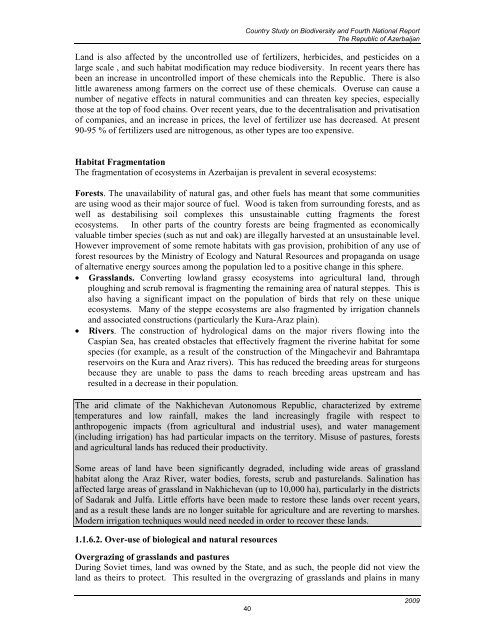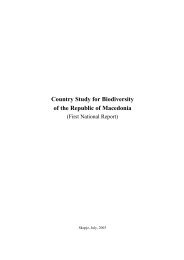CBD Fourth National Report - Azerbaijan (English version)
CBD Fourth National Report - Azerbaijan (English version)
CBD Fourth National Report - Azerbaijan (English version)
Create successful ePaper yourself
Turn your PDF publications into a flip-book with our unique Google optimized e-Paper software.
Country Study on Biodiversity and <strong>Fourth</strong> <strong>National</strong> <strong>Report</strong><br />
The Republic of <strong>Azerbaijan</strong><br />
Land is also affected by the uncontrolled use of fertilizers, herbicides, and pesticides on a<br />
large scale , and such habitat modification may reduce biodiversity. In recent years there has<br />
been an increase in uncontrolled import of these chemicals into the Republic. There is also<br />
little awareness among farmers on the correct use of these chemicals. Overuse can cause a<br />
number of negative effects in natural communities and can threaten key species, especially<br />
those at the top of food chains. Over recent years, due to the decentralisation and privatisation<br />
of companies, and an increase in prices, the level of fertilizer use has decreased. At present<br />
90-95 % of fertilizers used are nitrogenous, as other types are too expensive.<br />
Habitat Fragmentation<br />
The fragmentation of ecosystems in <strong>Azerbaijan</strong> is prevalent in several ecosystems:<br />
Forests. The unavailability of natural gas, and other fuels has meant that some communities<br />
are using wood as their major source of fuel. Wood is taken from surrounding forests, and as<br />
well as destabilising soil complexes this unsustainable cutting fragments the forest<br />
ecosystems. In other parts of the country forests are being fragmented as economically<br />
valuable timber species (such as nut and oak) are illegally harvested at an unsustainable level.<br />
However improvement of some remote habitats with gas provision, prohibition of any use of<br />
forest resources by the Ministry of Ecology and Natural Resources and propaganda on usage<br />
of alternative energy sources among the population led to a positive change in this sphere.<br />
• Grasslands. Converting lowland grassy ecosystems into agricultural land, through<br />
ploughing and scrub removal is fragmenting the remaining area of natural steppes. This is<br />
also having a significant impact on the population of birds that rely on these unique<br />
ecosystems. Many of the steppe ecosystems are also fragmented by irrigation channels<br />
and associated constructions (particularly the Kura-Araz plain).<br />
• Rivers. The construction of hydrological dams on the major rivers flowing into the<br />
Caspian Sea, has created obstacles that effectively fragment the riverine habitat for some<br />
species (for example, as a result of the construction of the Mingachevir and Bahramtapa<br />
reservoirs on the Kura and Araz rivers). This has reduced the breeding areas for sturgeons<br />
because they are unable to pass the dams to reach breeding areas upstream and has<br />
resulted in a decrease in their population.<br />
The arid climate of the Nakhichevan Autonomous Republic, characterized by extreme<br />
temperatures and low rainfall, makes the land increasingly fragile with respect to<br />
anthropogenic impacts (from agricultural and industrial uses), and water management<br />
(including irrigation) has had particular impacts on the territory. Misuse of pastures, forests<br />
and agricultural lands has reduced their productivity.<br />
Some areas of land have been significantly degraded, including wide areas of grassland<br />
habitat along the Araz River, water bodies, forests, scrub and pasturelands. Salination has<br />
affected large areas of grassland in Nakhichevan (up to 10,000 ha), particularly in the districts<br />
of Sadarak and Julfa. Little efforts have been made to restore these lands over recent years,<br />
and as a result these lands are no longer suitable for agriculture and are reverting to marshes.<br />
Modern irrigation techniques would need needed in order to recover these lands.<br />
1.1.6.2. Over-use of biological and natural resources<br />
Overgrazing of grasslands and pastures<br />
During Soviet times, land was owned by the State, and as such, the people did not view the<br />
land as theirs to protect. This resulted in the overgrazing of grasslands and plains in many<br />
40<br />
2009

















